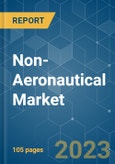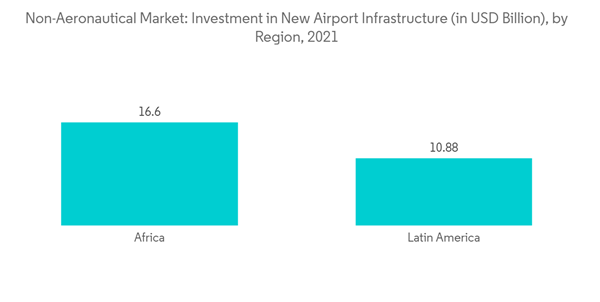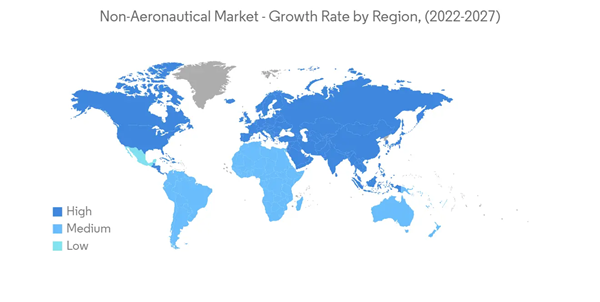The global aviation sector faced unprecedented challenges due to the COVID-19 pandemic. The pandemic significantly affected the aviation sector, which resulted in a drastic reduction in passenger traffic, which has negatively affected demand for airport operations. According to the International Air Transport Association (IATA) report 2020, the global demand for air cargo witnessed a significant decline in 2020. Asia-Pacific airlines witnessed cargo demand fall by 15.5% in February 2020 compared to January 2020. The aviation sector saw significant recovery post-COVID-19 due to reduced restrictions and increased air traffic, which resulted in the growing demand for non-aeronautical services.
The rapid expansion of the aviation sector and increasing investments in non-aeronautical services at airports for enhancing passenger comfort drive the market's growth. An increasing number of airports leads to the growing demand for food services, car rental services, cargo handling systems, and other non-aeronautical services boosting the market growth. The revenue for non-aeronautical services is generated through rents charged to concessionaires that offer a wide range of services to passengers. These services include car parking at the airports, banking, advertising, retail, and car rental facilities on the airport site.
Stringent regulations related to air cargo screening by the Transportation Security Agency (TSA) and other regulatory bodies in the European Union (EU) have forced several airports to enhance their existing cargo screening systems. Thus, the growing demand for non-aeronautical services at airports drives market growth.
Non-Aeronautical Market Trends
Ground Handling Systems Will Showcase Significant Growth During the Forecast Period
The ground handling systems segment is estimated to show remarkable growth during the forecast period. The aircraft ground handling systems consists of equipment used to offer services to an aircraft while it is on the ground and parked at a terminal gate. The ground support equipment includes power systems, baggage handling systems, security systems, water service vehicles, and others.An increasing number of air travelers and growing spending on the aviation sector leads to rising demand for ground handling systems. According to the International Air Transport Association report, the aviation sector witnessed a strong recovery after the pandemic. The overall number of air passengers will reach 4 billion by 2024. The report stated that in 2021, the numbers were 47% of 2019 levels. The number of air travelers is expected to improve to 83% in 2022, 94% in 2023, 103% in 2024, and 111% in 2025. This leads to growing airports, creating demand for ground handling systems. In May 2022, G3 Global Bhd, an artificial intelligence company, signed a contract worth RM118.38 million from Malaysia Airports Holdings Bhd (MAHB) to design and develop an airport-integrated security and safety system (AIS3) for the KL International Airport (KLIA) and KLIA2. Thus, the rising procurement contract of ground handling systems propels market growth.
Asia Pacific is Estimated to Show Highest Growth During the Forecast Period
Asia-Pacific is projected to show remarkable growth during the forecast period. The growth is due to rising cargo traffic, a growing number of airports, and increasing expenditure on the aviation sector from emerging economies such as China and India. In Asia-Pacific, major countries like China, India, Japan, and Singapore are planning to construct new airports and expand the existing airports. An increasing number of airports leads to rising demand for non-aeronautical services, thus driving the growth of the market.In February 2020, the Indian government announced that 100 new airports would be built by 2024. This will create demand for food and beverage services, car rental services, baggage handling equipment, and other services. Furthermore, in June 2022, the Union Civil Aviation Minister of India announced that the country will have 33 additional cargo terminals by 2024-2025.
For instance, in November 2022, Tata Starbucks announced that it is planning to open eight airport stores across six cities in the country to expand its network. The cities are Bhubaneswar, Bengaluru, Goa, Jaipur Guwahati, and Lucknow. Furthermore, in October 2022, Smoor, the luxury chocolate brand opened a new café at the Bangalore International Airport (BAIL). Thus, rising investment in non-aeronautical services for improving passenger comfort at the airport drives market growth across the Asia Pacific.
Non-Aeronautical Market Competitor Analysis
The market for non-aeronautical services is fragmented in nature and is characterized by several suppliers who provide various services at airports. However, some of the prominent players in the non-aeronautical market are Aena SME SA, GROUPE ADP, Airport Authority Hong Kong, Airports of Thailand Plc, Fraport Group, and Heathrow (SP) Ltd. With the growing competition in the industry, the service providers are highly focused on enhancing passenger experience at airports. In August 2022, Aena Desarrollo Internacional, a subsidiary of airport services operator Aena, won a concession contract for 11 airports in Brazil for 30 years, with the possibility of an additional five years. The contract is scheduled to be signed in February 2023. The value of the contract was USD 473 million.Additional benefits of purchasing the report:
- The market estimate (ME) sheet in Excel format
- 3 months of analyst support
This product will be delivered within 2 business days.
Table of Contents
Companies Mentioned (Partial List)
A selection of companies mentioned in this report includes, but is not limited to:
- AENA SME SA
- GROUPE ADP
- Airport Authority Hong Kong
- Airports of Thailand Plc
- Fraport Group
- London Heathrow Airports Limited
- Japan Airport Terminal Co. Ltd
- Vinci SA
- Airports de Paris SA
- Korea Airports Corp










